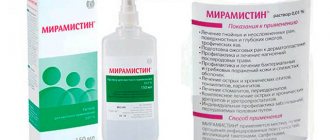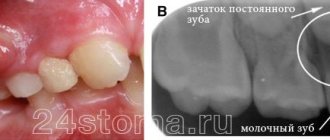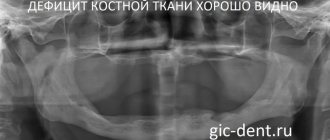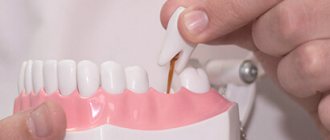Pediatric dentistry can be considered a separate section of modern dental practice, because due to the structural features, the treatment of baby teeth is somewhat different from the treatment of permanent teeth. Unfortunately, many parents are still convinced that baby teeth do not need dental care - after all, they will soon break down and fall out anyway. Therefore, children are not taken to the dentist very often, and if they are taken to the doctor, it is with advanced diseases and multiple problems.
In fact, dental treatment should be carried out at any age, and the sooner you consult a doctor with a problem, the higher the likelihood of getting rid of it quickly and without any complications. If a child has bad baby teeth, this will inevitably affect the health of his permanent ones - this is what parents need to remember when they want to “pity” the baby and not take him to an appointment with the “evil dentist.”
Gum inflammation
The most common inflammatory gum diseases in children are stomatitis and gingivitis. Stomatitis, or, as it is usually called, thrush, is an infectious inflammatory process provoked by fungi of the genus Candida. Treatment is antifungal and anti-inflammatory therapy, always carried out under the supervision and recommendations of a dentist. Self-medication can be dangerous, as some children may have allergic reactions to certain medications or antiseptics.
Gingivitis most often occurs due to plaque on baby teeth and insufficient general hygiene, but the reasons for their development can also be trauma to the gums during teething or other injuries, untreated caries. With this problem, you also need to contact a doctor, who will select the optimal treatment regimen and prevent gingivitis from developing into childhood periodontitis.
Types of child reactions to dental treatment
The types of reactions listed below are not a professional psychological classification, but rather reflect the experience of a pediatric dentist.
- Conditionally normal reaction. The child fulfills all requests of the doctor and parents. Doesn't cry, doesn't scream, even when discomfort occurs, he behaves calmly.
- Closing in on oneself. The child does not comply with the requests of the parents and the doctor and remains silent. You may not be able to sit in a chair at all.
- Crying and hysterics. The child not only cries, but may call him names and try to hit the doctor and parents.
In the first case, treating a child is not difficult; these children can be given anesthesia and perform all manipulations. This is how children usually react to treatment after 7-9 years of age. They can already articulate their fear. If everything is explained to them correctly, there will be no problems with the manipulations.
In the second case, it is not always possible to carry out treatment, but you can try to establish contact with the child and introduce the child to the office.
In the latter case, manipulation is very difficult. If assistance is urgently needed, anesthesia or a visit to the maxillofacial department is required.
Caries, pulpitis and periodontitis of primary teeth in children
Milk teeth have thinner enamel and dentin layers than permanent teeth, they have a larger pulp chamber and, therefore, infection spreads faster to the pulp. They are more often susceptible to carious lesions - and not least because of night feeding or the habit of drinking drinks from a bottle at night (mostly sweet or sweetened - tea, juices).
In addition, caries is often provoked by plaque on baby teeth, which forms faster than in adults, and which not all parents are in a hurry to remove. Many people begin brushing their children’s teeth at a more or less conscious age, while a child should be taught hygiene and regularly remove plaque from the moment the first teeth erupt, that is, from about six months of age. Also, the cause of diseases of the dental system can be an insufficient amount of solid food in the baby’s diet, since chewing solid food helps to clean the dental surfaces themselves.
The child's nutritional habits, lack of hygiene, and too thin enamel layer provoke a phenomenon called circular caries of baby teeth - carious lesions spread over the entire tooth surface, as if encircling the crown.
Caries quickly turns into pulpitis - an inflammatory lesion of the dental pulp. Most often, a doctor is consulted precisely at this stage of the infectious process, ignoring the initial stages of damage to dental tissues. Pulpitis, in turn, provokes periodontitis of primary teeth in children - inflammation of the periodontal tissues near the tips of the tooth roots. This condition is usually accompanied by severe pain, severe swelling of the affected area, and often an increase in body temperature.
Classic method of caries treatment
If caries has already developed, then it will have to be treated using the standard method, using drilling of the carious cavity and filling it. And the parent’s task is to prepare the child for this procedure , to form a positive attitude towards the doctor. Today, in order to arouse children's interest in treatment, children's doctors install colored fillings, which the child can choose according to his own taste. This is quite a strong motivation for a child, who can then show off his beautiful teeth to his friends. Treatment with a drill provides pain relief for small patients.
Moreover, before the injection, the doctor numbs the injection site with a special gel. The treatment procedure should not exceed 30 minutes, otherwise the child will get tired. Frequent breaks in the treatment procedure are required.
If the baby behaves very restlessly, then doctors recommend giving him a tablet of children's Tenoten for resorption 20 minutes before the appointment. The medicine significantly reduces anxiety , improves mood and removes fear.
In modern dental centers, parents can be offered a sedation procedure for children who are not amenable to treatment, categorically refusing it. Using a mask with nitrous oxide, the child is put into a shallow sleep , after which anesthesia and then treatment are carried out.
As a last resort, anesthesia is used, but only according to the pediatrician's indications. In order not to lead children to deep caries, you need to know preventive measures against it.
Treatment of baby teeth
At the initial stages, caries is treated without tissue preparation - remineralization of the enamel, as well as modern Icon technology, which allows filling without drilling, easily cope with carious lesions of the enamel layer. In later stages, when the dentinal layer is affected, as well as in the case of pulpitis and periodontitis, treatment of baby teeth with tissue preparation will be required. You should not be afraid of such procedures - modern methods of anesthesia allow them to be carried out completely painlessly and comfortably for a small patient. In addition, the anesthetics used are harmless, with a minimum concentration of the active substance. And the site of the upcoming injection itself is numbed by applying a special gel or spray (application anesthesia).
Experienced dentists try to carry out treatment quickly so that the child does not have time to get tired and capricious. If a child has bad baby teeth and a large amount of work is required, it is divided into several stages. It also happens that the child does not want to contact the doctor, is too afraid of treatment, or the volume of manipulation is too large and serious - in such a situation, it is possible to carry out therapy under anesthesia or with intravenous sedation (with a preliminary examination).
In case of pulpitis, the root canals are filled with special pastes that dissolve simultaneously with the “milky” root, so there is no chance that the medicinal material will remain in the tooth socket and will prevent the new tooth from growing properly.
What to do when a child is very afraid and does not want to have his teeth treated: how to persuade him to go to the dentist
Some modern techniques, developed jointly with psychologists, involve exciting adventures, while others involve a preliminary study of possible problems. Below we talk about the most successful and popular practices that can be easily adapted to Russian reality.
Playing doctor
This is a unique tool for understanding the world around us, especially in childhood. Even the most unremarkable and disgusting things seem more attractive and interesting if they are presented in a positive playful way. Turning a standard trip to the dentist into a real adventure is an art. However, if you don’t want your baby to develop dental phobia, this is exactly what you should do.
Below are the most successful entertainment scenarios:
- Offer to treat your favorite toy's teeth. The child will be so interested in the process that he will want to check the condition of his own.
- Role-playing game. Something from the “mother-daughter” category, only “doctor-patient”. First, the parent will act as a dentist - just to explain and tell how everything works. And then the baby will try on this image. Such tricks help dispel fears before visiting the office.
- A fairy tale about the good doctor Aibolit. Before your visit, you can watch the old cartoon.
Of course, this is not a complete list of all games. You are free to invent and propose your own. The main thing is to create a comfortable psychological environment.
Reward and encouragement
Just as bad behavior in a dental clinic should be discouraged, good behavior should be rewarded. It is best to give the gift to the doctor so that he, in turn, gives it to the baby. Such a simple manipulation will win the favor of the little patient.
However, gifts should not become a management tool. During each visit, the child is introduced to the culture of health care and is more responsible about the state of the oral cavity.
Cartoons during treatment
Watching your favorite cartoon during a visit will help you take your mind off what the doctor is doing and concentrate on something more pleasant. This technique is actively practiced by dentists at Dentic Kids.
Own example
Of course, cartoons, games, gifts are all very good. But remember, nothing works better than a worthy personal example. If you yourself literally faint at the mere mention of the need to see a dentist, it is unlikely that you will be able to develop a love for this specialist in your children. That is why, before raising them, it is important to work through your own fears and phobias.
If, on the contrary, you understand the importance of dental treatment and endure any procedures, then it would be a good idea to go to the session with your baby. There he will see your positive attitude and will quickly be charged with the right mood.
Restoration of baby teeth
If a child’s baby tooth breaks off or if the dental crown is severely damaged by caries, restoration is carried out. However, if for adult patients one of the most important aspects during restoration is aesthetics, then for children functionality is much more important. Therefore, restorative filling materials are always selected taking into account the patient’s age - for children, durability and impeccable aesthetics are not so important, a good marginal fit of the fillings and the preservation of dental tissues are much more important. Filling materials that are too strong can put pressure on dental tissues and contribute to their destruction, and therefore dentists choose materials that will recreate and maintain the integrity of the dental crown until the moment of natural tooth loss.
How to overcome dental phobia
If we consider that, according to statistics, by the time they enter school, 90% of children are already familiar with toothache, then it is clear that the formation of correct attitudes regarding dental treatment is necessary for every child.
- When teaching your child to brush his teeth, it is necessary to give any arguments in favor of this procedure, except for horror stories about dental treatment, which is inevitable in case of poor dental care.
- If you have healthy teeth, it’s a good idea to make 1-2 adaptation visits to the dentist to get acquainted with the situation in the office and perform the required actions - opening the mouth, instrumental examination. The child is convinced that visiting the doctor does not pose any danger. At the same time, parents get the opportunity to take a closer look at the way the dentist treats the baby.
- You cannot share negative experiences with dental treatment in the presence of children.
- In a preliminary conversation before a visit to the dentist, parents should avoid mentioning injections and upcoming pain. Modern medicine has a large arsenal of tools for painless dental treatment. The younger the child, the more delicately the conversation needs to be conducted.
- If a child experiences toothache when eating or at rest at night, you need to draw his attention to the fact that the pain arose spontaneously, not from the actions of the dentist. It must be emphasized that only a doctor can relieve discomfort.
- Parents should take care in advance of choosing a well-equipped clinic and a doctor who has the appropriate specialization and knows how to find an approach to the child.
- After completing the treatment, you need to arrange a pleasant surprise for the baby - buy a toy or fulfill a long-standing promise.
Removal of baby teeth in children
Removal of baby teeth in children is carried out only for specific indications or in the case when the tooth is ready to fall out on its own and just needs a little “help”. If there is a choice - to remove or treat, a competent dentist will always advise treatment, since the early loss of baby teeth leads to a number of serious disorders of the dental system, including the appearance of permanent bite defects.
Extraction operations should be carried out exclusively in the dentist’s office - attempts to remove teeth at home can lead to injury to soft tissues, infection of the socket, injury to the rudiment of a permanent dental unit, etc. The doctor will perform the extraction under local anesthesia quickly, competently and completely painlessly.
Appearance
What do teeth that have undergone restoration look like? Look at the photos below. If everything is done correctly, the new teeth will not differ from your own teeth located next door.
Photos before and after
The psychological aspect in the matter of dental restoration is of considerable importance. If a child feels the mocking attitude of peers, this can lead to disturbances in the formation of personality, character, and a decrease in the level of self-esteem. With such a burden it will not be easy for him to start his adult life. Consider this if you are simply going to remove a decayed front tooth. Maybe it’s still worth fighting for it?
What to do if baby teeth grow crookedly?
If parents notice that their child’s baby teeth are growing crookedly - for example, there is crowding or improper occlusion - this is a reason for a mandatory consultation with a pediatric orthodontist. It happens that due to anomalies of the facial skeleton (in particular, improper development of the jaws), defects are noticeable even with a primary bite, and with a permanent bite they will persist and worsen.
Therefore, it is recommended to show the child to an orthodontist from the age of three to determine whether there is pathology and find methods for its correction. There are malocclusions that are easily corrected at an early age and extremely difficult to correct in adults.
How to protect baby teeth from caries?
Prevention is the best way to cope with any disease. Therefore, those parents who care about the health of their children should definitely think about caries prevention. How to protect baby teeth from caries? The recommendations of experts in this matter are as follows:
- The correct diet for the mother during pregnancy is with a sufficient amount of foods containing calcium, fluorine and phosphorus: cottage cheese, beef and beef liver, sea fish, nuts, fruits and vegetables, cereal porridges.
- Compliance with hygiene standards: daily brushing from the moment the first teeth appear, first with a cotton or gauze swab with boiled water, then with special baby brushes and pastes. Plaque on baby teeth should be removed promptly and thoroughly.
- A healthy diet for a child: as little fast carbohydrates, carbonated drinks, sweets as possible, more fruits and vegetables, cereals, and dairy products.
- Timely visits to the dentist for preventive examinations (at least once every six months).
It is important that parents develop a conscious attitude towards the health of their children's teeth and oral cavity in general. A timely visit to the dentist in case of any identified problems, as well as for regular medical examinations, will help maintain the health of the child’s dental system – and therefore the digestive system too.
Where does fear come from?
Dentophobia is the name given to the fear of treatment at the dentist. If it is present, a person seeks the help of a specialist only in extreme cases, when there is no longer any possibility of enduring the pain. Children also suffer from it. At a young age, fear is usually caused by already acquired negative experiences. At the same time, it is not the dentists themselves who may frighten the baby, but the “white coats” in general. If you do not overcome this phobia in childhood, it will spread into adulthood, and then it will be almost impossible to get rid of it.
If you don’t know how to force your child to go to the dentist, but he refuses to have his teeth treated, first of all you need to find out the reason for what is happening. Most often, fear occurs for the following reasons:
- the baby sees a doctor for the first time or experiences severe pain;
- there are character traits - suspiciousness, shyness, indecisiveness;
- Previously, the baby had already been forcibly held in a dental chair for some procedures, a negative experience was ingrained in his head;
- the parent could not explain why it is important to go to the dentist, why all these manipulations are needed.
Note that young children almost always react negatively to examination of the oral cavity. This seems something unnatural, and that is why it is perceived so hostile. The general goal of parents is to convince the baby that there is nothing wrong with what is happening. On the contrary, it will help him be healthy and beautiful.
In addition, it is important to combat the fear of “white coats.” The baby should not be afraid of doctors, because in any case he will have to contact them. Not necessarily for treatment - preventive examinations in kindergarten and school have not been canceled.











